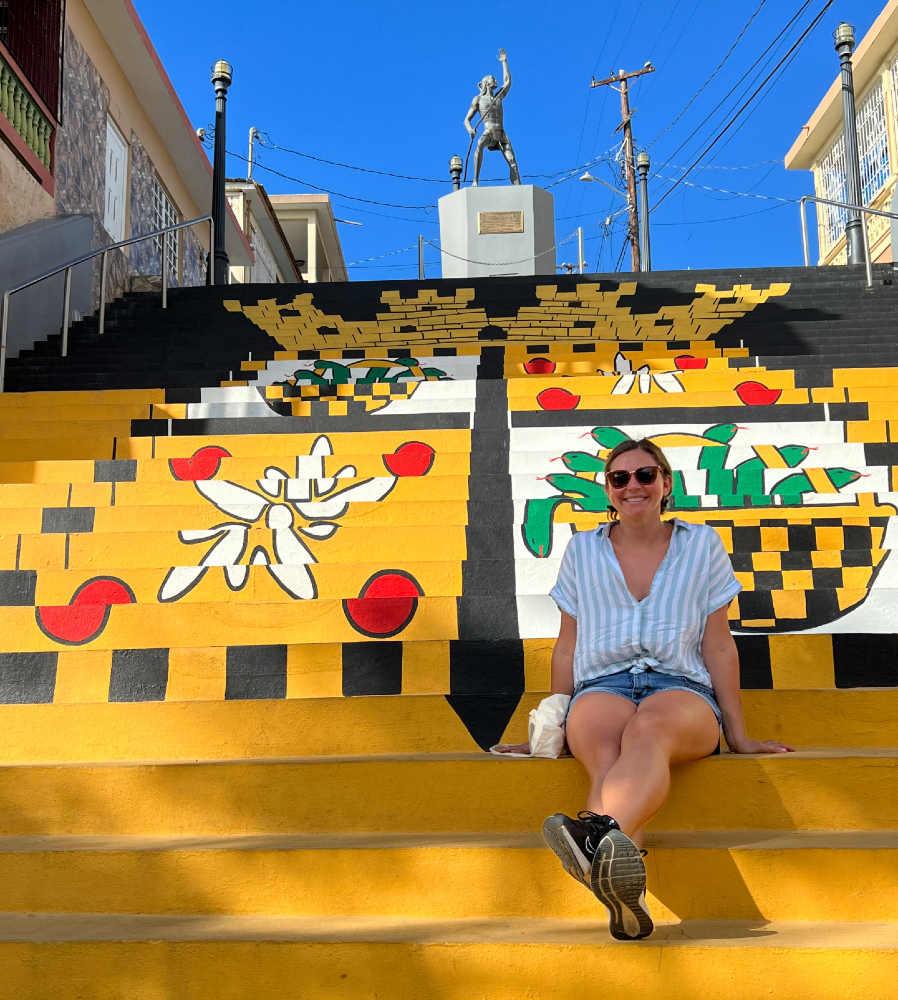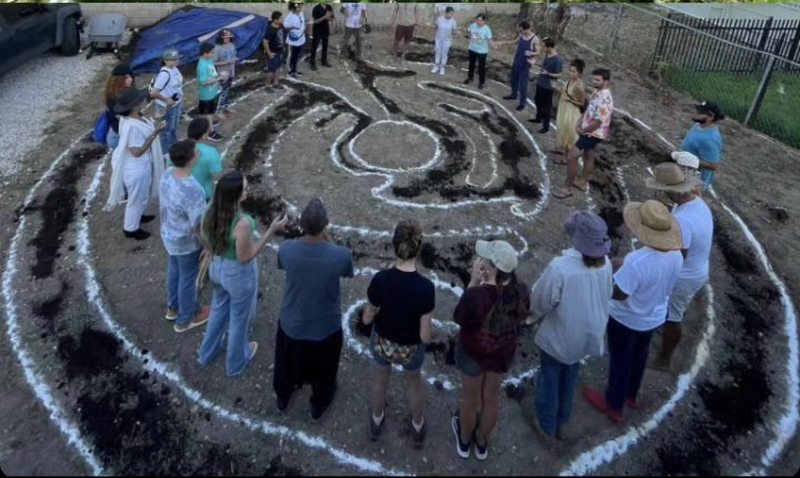博士生卡洛琳·沃森对加勒比海考古和气候灾害的NPS研究做出了重要贡献

This summer, Ph.D. student Caroline Watson worked as the Climate Change and Cultural Resources intern for the Climate, Science, and Disaster Response program of the National Park Service, contributing to important work aimed at mitigating climate impacts on archaeological sites. This position focuses on monitoring the impacts of climate on archaeological resources in the Caribbean, with the goal of developing strategies and solutions aimed at mitigating these. Caroline’s role in this National Center for Preservation Education internship overlapped significantly with her own doctoral project on the impacts of hurricanes and other environmental disasters on the people and landscape of Puerto Rico. For this spotlight article, Caroline sat down with her friend and colleague Tomos Evans to discuss her work, how it connects with her Ph.D. project, and her broader intellectual journey as a researcher of climate and of the archaeology and cultural anthropology of the Caribbean.
Caroline’s fascination for Caribbean history and culture first developed as an undergraduate student at Wake Forest University, when she accompanied a professor on a research trip to Cuba in 2016. “As an undergraduate I was introduced to the Cuban art and visual cultural production scene by one of my closest mentors – the Romance Language professor Linda Howe. She and her colleague Elvia Rosa Castro brought me to Cuba with them, which inspired me to study the art world there.” Caroline’s enthusiasm for the cultural heritage of the Caribbean, her friendships with a number of Caribbeanist scholars, and her fluency in Spanish, meant that she was well-positioned to soon begin conducting her own independent research. Through a connection at the Smithsonian Institution – Antonio Curet, a Puerto Rican archaeologist – Caroline visited Puerto Rico in the summer of 2022 to work on a museum collection at the Tibes Indigenous Ceremonial Centre, a Taíno archaeological site and museum. An important settlement of the indigenous Taíno people, the site consists of spectacular cultural features including ball courts, burials, petroglyphs, and evidence of extensive occupation in the pre-Columbian era.
It was while working on the collections here that Caroline came face-to-face with the impacts of climate and natural disaster on cultural heritage. “I was working at the museum re-cataloguing bags of artefacts. The plastic bags had deteriorated in the increasingly humid climate, and when the earthquakes struck in January 2020, shelves were destroyed and bags split leading to everything from crab shells, lithics, ceramic sherds, beautiful anthropomorphic figurines, to human bones spilling out over the floor.” The museum staff lacked the resources to continue to care for these objects in the way they wanted, and were not well equipped to deal with future environmental challenges threatening their incredible collection. Caroline therefore felt galvanized to take her research in a new direction: to focus on the archaeology of disaster in Puerto Rico, and the impacts of climate and other environmental stressors to archaeological resources.
Caroline’s work with NPS was a perfect fit with her newfound research interests, and offered her a valuable opportunity to contribute to efforts to monitor and mitigate the effects of climate change on the historic cultural heritage of the Caribbean. “My work with NPS is to research climate change impacts to archaeological resources as well as corresponding adaptation strategies. Within that, I had a lot of freedom to design how I wanted to research this broad topic.” As there is only one U.S. National Park in Puerto Rico, Caroline decided to undertake a wider investigation of these issues in Tropic/Sub-Tropic regions, including the Caribbean more broadly. She has conducted literature reviews, studies of climate policy, and interviews with a number of key stakeholders in Puerto Rico, the US Virgin Islands, Cuba, the Lesser Antilles, Hawaii, Guam, the Florida Keys, and more. “I have been thinking about how climate change is materializing at the shores of island society in the Caribbean, and impacts to archaeological sites is one way to look at this. I was really interested in what they call “adaptation strategies” – a fancy way of saying “we want to know about how to mitigate these impacts.” Impacts include sea level rise, extreme weather events, hurricanes, extreme changes in precipitation, and anthropogenic impacts like sand mining and real estate development. So, I’m exploring the strategies that people have used to mitigate these impacts to archaeological resources, and what more can be done.”
Importantly, this process involved interviews of archaeologists working at sites located on shorelines that are regularly affected by extreme weather, sea level rise, and erosion. This exposed Caroline to a range of perspectives regarding strategies of how to adapt to these challenges, or in more severe cases, how to salvage material from sites likely to be destroyed by manmade changes to the environment. For example, dune-building projects are aimed at restoring sand dunes impacted by hurricanes, which act as natural barriers that protect archaeological sites from the sea. These interviews have also delved into how archaeologists prepare for loss, especially in cases where sites won’t exist by the end of the decade. Caroline’s experiences on the ground in Puerto Rico and elsewhere in the Caribbean have revealed to her the importance of localized research, perspectives, and solutions, especially in the face of a National Park Service zoning policy that groups Puerto Rico and the US Virgin Islands with the US southeast (including states such as Kentucky and Tennessee). “These places don’t experience hurricanes with the same frequency and same intensity as the Caribbean: they should not be zoned together like this.” As such, her research looks to support such local approaches, as well as stimulate novel conversations pertaining to the interconnectedness of climate disasters (hurricanes, warming seas, the death of coral reefs etc.) and the co-complexities of how these things affect both everyday life on Caribbean islands and archaeological resources in these places.
While her internship has involved researching the destruction of archaeological sites due to climate, Caroline’s dissertation will also be exploring the ways in which climate disasters are memorialized, creating new places in landscape memory. Through ethnographic and archaeological research, she is seeking to understand the experiences of how people live with these events, how they become a part of everyday life and identity, and how they may even generate new archaeological sites and spaces. She is posing a number of questions to better explore these social phenomena: “What does it mean to be prepared? What does it mean to be vulnerable? How is resilience embodied and materialized? How do these social variables relating to climate disaster manifest in the physical landscape of Puerto Rico?” Just as a tropical storm may forever destroy an archaeological site on the shoreline, so too might it generate new ones – for instance, where people communally pile up layers of refuse and rubble as they deal with the trauma and tragedy of these events together. “Hurricanes don’t merely remove, they generate. They expose new archaeological sites and create new ones. For instance, the Tibes site that I mentioned earlier is said to have been exposed by Hurricane Eloise in 1975.”

在谈话的最后,卡罗琳讨论了她在波多黎各庞塞的论文研究中正在进行的一些具体的合作。她一直在与庞塞地区的社区团体合作,如La Casa de Arte y Cultura de La Playa de Ponce和Para La Naturaleza,不仅让自己沉浸在庞塞社区中,还了解了更多关于地方一级恢复力组织的信息。她扩展的一项合作将是挖掘一座20世纪早期的住宅——罗莎·路易莎之家——像许多住宅一样,它遭受了地震、飓风、火灾和维修延误的创伤。Caroline正在与住宅业主合作,专注于他们如何利用破坏的物质来重新想象这个家庭的未来,并促进社区围绕伴随气候和社会灾难的挥之不去的创伤进行对话。他们正在考虑生活在灾难的余波中意味着什么,走过这样的废墟,想起这些反复发生的事件所带来的痛苦、损失和创伤。在人为气候变化是许多创伤事件背后的驱动力的时候,考古学可以成为这个波多黎各南部社区治愈创伤的工具。“对废墟的共同探索为人们提供了机会,让他们回到这些过去遭受创伤的地方,并开始更积极地看待它们;考古学可以作为一种媒介来参与这些动态,激发这些困难的对话。”通过她的研究,卡洛琳将继续成为这些社区努力的一部分,在这些灾难发生后恢复活力,并将继续支持受这些事件影响的人们。

















